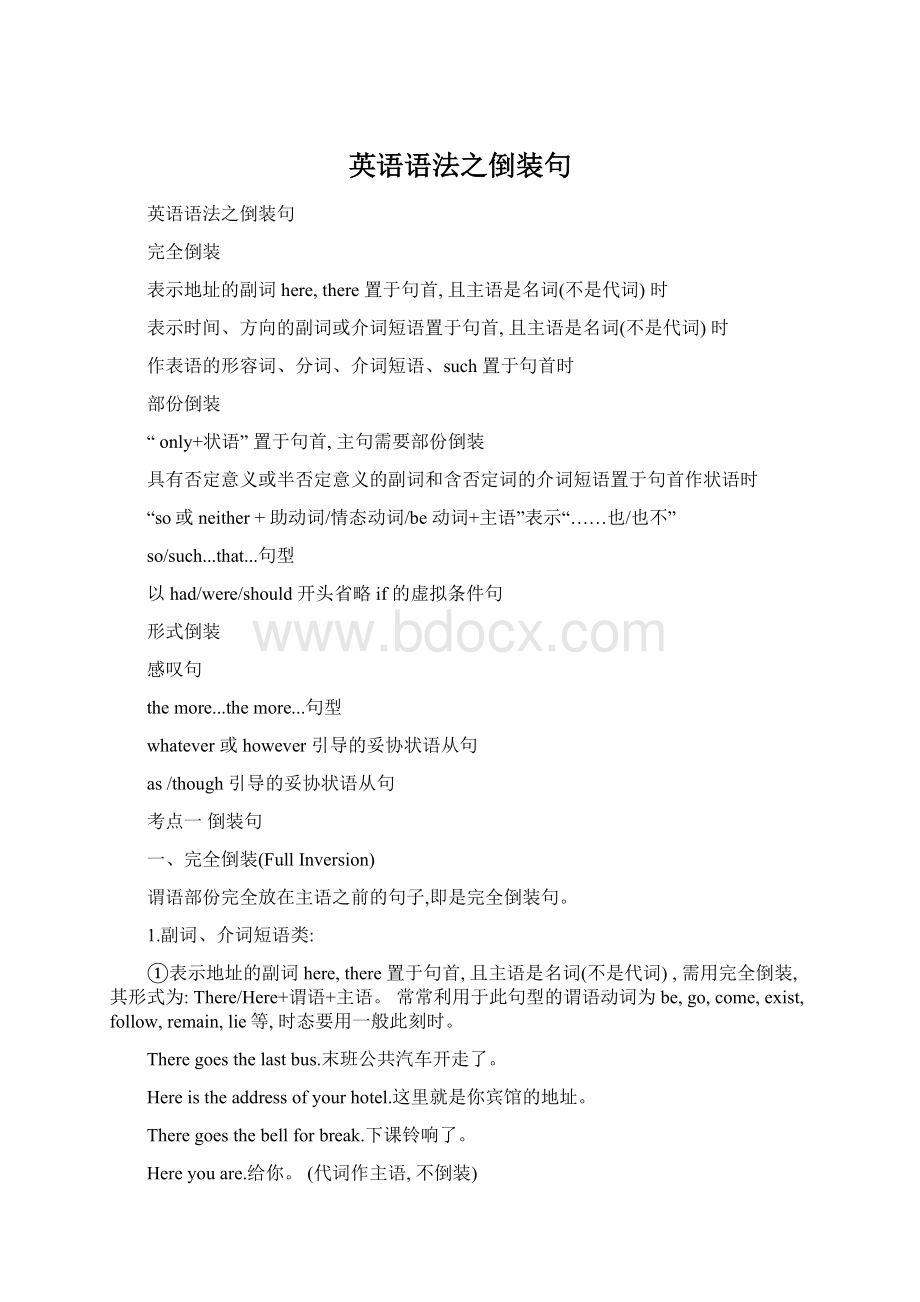英语语法之倒装句文档格式.docx
《英语语法之倒装句文档格式.docx》由会员分享,可在线阅读,更多相关《英语语法之倒装句文档格式.docx(7页珍藏版)》请在冰豆网上搜索。

①表示地址的副词here,there置于句首,且主语是名词(不是代词),需用完全倒装,其形式为:
There/Here+谓语+主语。
常常利用于此句型的谓语动词为be,go,come,exist,follow,remain,lie等,时态要用一般此刻时。
Theregoesthelastbus.末班公共汽车开走了。
Hereistheaddressofyourhotel.这里就是你宾馆的地址。
Theregoesthebellforbreak.下课铃响了。
Hereyouare.给你。
(代词作主语,不倒装)
②表示时间的副词(如:
now,then等)、运动方向的副词(如:
out,in,up,down,away等)及表示地址的介词短语置于句首,且主语是名词(不是代词),需用完全倒装,其形式为:
副词或介词短语+谓语+主语。
常常利用于此句型的谓语动词为come,fall,follow,exist,lie,go,remain,run等,时态为一般此刻时或一般过去时。
Nowcomesyourturn!
此刻该你了!
Upwentthearrowintotheair.箭直射向空中。
Underthetablesleepsawhitecat.在桌子下面睡着一只白色的猫。
Behindthecounterhestood.他站在柜台后面。
2.表语类:
为了维持句子平衡或强调表语部份等,将作表语的形容词、分词、介词短语、such置于句首时,需用完全倒装,其形式为:
形容词/此刻分词/过去分词/介词短语/such+be+主语。
Happyarethosewhoarecontented.知足者常乐。
Growingalloverthemountainarewildflowers.漫山遍野长满了野花。
Seatedonthegroundareagroupofyoungpeople.席地而坐的是一群年轻人。
Insidetheparcelwasaletter.包裹里有封信。
Suchwerehiswords.(=Suchwaswhathesaid.)这就是他说的话。
二、部份倒装(PartialInversion)
把be动词、助动词或情态动词置于主语之前的句子叫部份倒装句。
这种句型主要有下面几种:
1.only修饰副词、介词短语或状语从句,且放在句首时。
OnlyinthiswaycanwelearnEnglishwell.
只有效这种方式咱们才能学好英语。
利用特点:
(1)在部份倒装句中,若是谓语部份无助动词,则需找助动词来“帮忙”组成倒装句。
(x)Onlyafterthewarlearnedhethesadnews.
(√)Onlyafterthewardidhelearnthesadnews.
只是在战后他才得知那个不幸的消息。
(2)only修饰状语从句时,从句不可倒装,主句倒装。
(x)Onlywhendidhereturnwefoundoutthetruth.
(√)Onlywhenhereturneddidwefindoutthetruth.
只是当他回来的时候,咱们才查明了真相。
(3)only修饰主语时,句子不可倒装。
(x)Onlycanheanswerthequestion.
(√)Onlyhecananswerthequestion.只有他能回答这个问题。
题组训练单句填空
①(2021湖南,29)Onlywhenyoucanfindpeaceinyourheartwillyoukeepgoodrelationshipswithothers.
②(2021天津,6)OnlyafterMaryreadhercompositionthesecondtimedidshenoticethespellingmistake.
2.否定词never,nor,not,hardly,little,seldom,scarcely,rarely及表否定意义的介词短语atnotime,under/innocircumstances,innocase,bynomeans,onnocondition等置于句首时。
NeverbeforehaveIseensuchamovingfilm.=Ihaveneverseensuchamovingfilmbefore.
以前我从未看过这么动人的电影。
Notasinglemistakedidhemake.=Hedidn'
tmakeasinglemistake.
他一个错误也没犯。
HardlydoIthinkitpossibletofinishtheworkbeforedark.=Ihardlythinkitpossibletofinishtheworkbeforedark.
我以为在天黑之前完成这项工作几乎是不可能的。
③(2021辽宁,26)Atnotimedidtheyactuallybreaktherulesofthegame.Itwasunfairtopunishthem.
3.六个重要的固定句型:
(1)“so+be动词/助动词/情态动词+主语”意为“……也是如此”。
Theylovehavinglotsoffriends;
sodothosewithdisabilities.他们喜欢交很多朋友,那些身有残疾的人也是如此。
①此句型也可写成“itis/wasthesamewith...”或“soitis/waswith...”。
itisthesamewiththosewithdisabilities.
soitiswiththosewithdisabilities.
②若是仅是对前面内容的肯定或附和(此时的so=indeed),那么,句子不可利用倒装。
试比较:
A:
Iwasafraid.(I指的是A)
B:
SowasI.(I指的是B,此句意为:
Iwasafraid,too.)
我害怕。
我也是。
Soyouwere.(you指的也是A。
此句意为:
Indeedyouwereafraid.)
你就是这样。
(2)“neither/nor+be动词/助动词/情态动词+主语”意为“……也不这样”。
Lilycan'
trideabicycle;
neither/norcanLucy.
莉莉不会骑自行车,露西也不会。
①此句型也可写成“itis/wasthesamewith...”或“soitis/waswith...”。
itisthesamewithLucy.
soitiswithLucy.
②此句型中的neither/nor不可用so...not替代,但可用not...either改写。
(x)Ihaveneverbeenabroad.Sohasn'
the.
(√)Ihaveneverbeenabroad.Neither/Norhashe.
(√)Ihaveneverbeenabroad.Hehasnever/notbeenabroad,either.
我没出过国。
他也没有。
(3)如此……以至于……
So+adj./adv....that...
Such+(a/an+)adj.+n....that...
SoclearlydoeshespeakEnglishthathecanalwaysmakehimselfunderstood.
他说英语说得如此清楚,以至于他人都能听得懂。
Suchaninterestingbookdoeshehavethatweallwanttoreadit.
他有一本如此有趣的书,以至于咱们都想读。
在这个句型中,so,such后面的句子要倒装,而that引导的从句不倒装。
(4)Neither...,nor...意为“……不……,……也不……”。
NeitherdoIknowit,nordoIcareaboutit.
我不知道这件事,也不关心。
由于neither和nor都是不是定词,所以它们后面的句子均需倒装。
(5)Notonly...butalso...意为“不仅……而且……”。
Notonlywillhelpbegiventopeopletofindjobs,butalsomedicaltreatmentwillbeprovidedforpeoplewhoneedit.
不仅要给那些找工作的人提供帮忙,而且也要给那些有需要的人提供药物医治。
此句型也可写成Notonly...but...或Notonly...but...aswell的形式,但but(also)连接的句子必需用正常语序。
(6)Notuntil...意为“直到……才……”。
Notuntil4:
00inthemorningcouldhefallasleep.
直到早晨4点他才睡着。
Notuntilhereturneddidwehavesupper.
直到他回来咱们才吃晚餐。
可是:
Notuntildidhereturnwehadsupper.(x)
notuntil引导的是从句时,until从句的主谓不可倒装,只是主句需要倒装。
④Janewon'
tjoinusfordinnertonightandTomwon'
teither.
⑤Notuntilhelefthishomedidhebegintoknowhowimportantthefamilywasforhim.
三、形式倒装(FormalInversion)
形式上的倒装在语法上称为前置。
它的特点是:
只把强调的内容提至句首,主谓并非倒装。
这样的结构超级多,但有几个重要的句型需要特别注意:
1.感叹句
Whataninterestingtalktheyhad!
他们进行了一次何等有趣的谈话呀!
Howinterestingtheirtalkis!
他们的谈话何等有趣呀!
对名词(或中心词是名词)感叹时,用what引出;
对形容词或副词感叹时,用how引出。
2.themore...,themore...句型
ThemoreyoulistentoEnglish,theeasieritbecomes.
你听英语听得越多,它就变得越简单。
(1)此句型中的more代表的是形容词或副词的比较级,要灵活利用。
Theharderyouwork,thegreaterprogressyouwillmake.
你学习越尽力,取得的进步就越大。
(2)此句型中的第一个themore引导的部份相当于一个条件状语从句;
第二个themore引导的部份相当于一个主句。
所以,上面例句的意思实质上就是:
Ifyouworkharder,youwillmakegreaterprogress.
3.however,whatever引导的妥协状语从句
(1)“however+adj./adv.”引导的妥协状语从句
Howeverdifficulttheproblemmaybe,wemustworkitoutthisevening.
无论这个问题可能会有多难,今晚咱们必需解决它。
(2)“whatever+n.”引导的妥协状语从句
Whateverreasonsyouhave,youshouldcarryoutyourpromise.
无论你有什么理由,你都应当履行诺言。
4.as,though引导妥协状语从句时采用形式倒装的情况
(1)表语的倒装
Tiredas/thoughhewas,hestillwentonwithhiswork.
虽然很累,他仍是继续工作。
Strangeas/thoughitseems,itistrue.
虽然看上去奇怪,这事却是真的。
Exhaustedas/thoughshewas,shewasn'
tabletosleep.
虽然筋疲力尽,但她仍是睡不着觉。
注意:
若是是单数名词或形容词的最高级作表语,再也不用冠词。
Youngestas/thoughheisinourclass,hespeaksEnglishbest.
他虽然是咱们班年龄最小的,但他英语说得最好。
(2)谓语动词的倒装
Tryashemight,hedidn'
tpasstheexam.
虽然很用功,但他考试仍是不合格。
Searchastheywouldhereandthere,theycouldfindnothingintheroom.
虽然处处寻觅,但他们在房间里找不到任何东西。
行为动词前置时,从句主语后面要用may,might,can,could,will,would等情态动词,若没有情态动词,则需加上一个do(does或did)。
若前置的行为动词是及物动词,则其宾语也随其后一并提前。
Changeyourmindas/thoughyoudo,youwillgetnohelpfromus.
即便你改变主意,你也得不到咱们的帮忙。
(3)状语的倒装
Muchashelikesthebike,hedoesn'
twanttobuyit.
虽然他很喜欢那辆自行车,但他不想买它。
HardasIstudied,Icouldnotcatchupwiththem.
我虽然学习尽力,但仍是赶不上他们。
⑥Whataninterestingrolesheplayedinthefilm!
NowondershehaswonanOscar.
⑦Inrecentyearstravelcompanieshavesucceededinsellingustheideathatthefurtherwego,thebetter(good)ourholidaywillbe.
⑧Strangeas/thoughitmightsound,hisideawasacceptedbyallthepeopleatthemeeting.